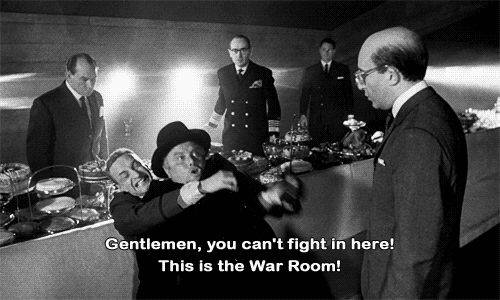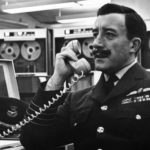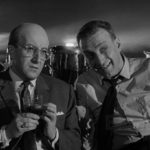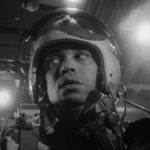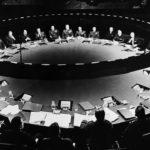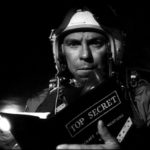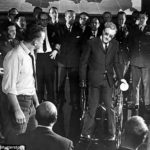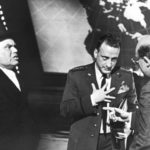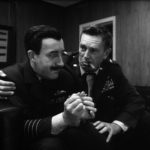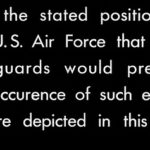General “Buck” Turgidson: Mr. President, about, uh, 35 minutes ago, General Jack Ripper, the commanding general of, uh, Burpelson Air Force Base, issued an order to the 34 B-52’s of his Wing, which were airborne at the time as part of a special exercise we were holding called Operation Drop-Kick. Now, it appears that the order called for the planes to, uh, attack their targets inside Russia. The, uh, planes are fully armed with nuclear weapons with an average load of, um, 40 megatons each. Now, the central display of Russia will indicate the position of the planes. The triangles are their primary targets; the squares are their secondary targets. The aircraft will begin penetrating Russian radar cover within, uh, 25 minutes.
President Merkin Muffley: General Turgidson, I find this very difficult to understand. I was under the impression that I was the only one in authority to order the use of nuclear weapons.
General “Buck” Turgidson: That’s right, sir, you are the only person authorized to do so. And although I, uh, hate to judge before all the facts are in, it’s beginning to look like, uh, General Ripper exceeded his authority.
As the late, great Roger Ebert states at the beginning of his review of this great movie, “every time you see a great film, you find new things in it.” This is as good a criterion as any I’ve ever come across, and describes Kubrick movies to a tee. The great director crafted each of his films, such that they not only stand repeated viewing but have underlying layers of complexity that can only be unravelled over time.
Like the best rock bands, for every vocalist and whizzy lead guitarist, you need a solid rhythm section to underpin the frothy top layer. In the case of Dr Strangelove, a movie that started life as a serious drama, and could easily have become Carry On Bombing but notched 3-4 levels higher in the hands of a director who was not interesting in churning films out by the yard but made bespoked timeless classics and whose primary concern is in telling the truth. Indeed, his predictions almost all come true (see here.)
While the comedic froth is provided by the genius that was Peter Sellers in his three roles (frightfully English Group Captain Lionel Mandrake, US President Merkin Muffley and mad German scientist, the eponymous Dr Strangelove), but the reason this film stands up to scrutiny 53 years on is both the inky black satire on nuclear politics that hits bullseye – and credit to Sellers for displaying that steel to underpin the deliciously ironic humour.
The reason the satire works so brilliantly is that the scenario is entirely credible (to the extent that a disclaimer is relayed at the beginning of the film explaining that the US armed forces believe their and every bit as relevant now as it was in 1964, it is played completely deadpan – and is all the funnier for the straight faces and deadly serious intent. All the better without the originally planned custard pie fight ending – slapstick truly would not work here. From Wikipedia:
It was originally planned for the film to end with a scene that depicted everyone in the war room involved in a pie fight. Accounts vary as to why the pie fight was cut. In a 1969 interview, Kubrick said, “I decided it was farce and not consistent with the satiric tone of the rest of the film.”
Oh, and the beautifully observed script, one which sounds all the wittier for reading the quotes in hindsight. Everywhere you look, there are finely-judged po-faced performancesnuances to cherish many times around. Nobody is shamed into submission by the inspirational Sellers, no easy feat in the face of a man whose tragic talent wiped out everything in its path, including Sellers.
George C Scott‘s comic genius as General Buck Turgidson (who would rather be home with his mistress) was recognised by Ebert second (or nth) time around, though he is matched every step by Sterling Hayden‘s delicious cameo as deranged base commander, commie-hater and preserver of American body fluids, General Ripper.
Don’t forget Slim Pickens‘ dutiful Texan pilot, Major “King” Kong either – his speech to his crew as a simple Texan is perfect for the job. With a last push of adrenalin and an invasion of Burpelson Air Base, all planes are finally reigned in by the top brass… except one, that of Major Kong, damaged by anti-aircraft fire and with seemingly no choice other than to pursue their quarry, come hell or high water.
But as a discussion point, let’s look at nuclear strategy. The film starts with the assumption that the Soviet Union, these being the days of the Cold War, has created a “doomsday machine“, a cobalt bomb that would cover the earth in radioactive fallout with a half life of 93 years. As Dr Strangelove points out in the film, the whole point of this device is Mutually Assured Destruction (ie. MAD), given that it would be detonated automatically in the event of a pre-emptive nuclear strike.
What the doomsday machine did not allow for were the three scenarios discussed in Dr Strangelove:
- Unpredictable human behaviour, whereby a general in the armed forced can use a guideline instituted in the event that the entire presidential machine were taken out to countermand the decision-making structure for his own ends, namely that he
- Poor communication (between Ripper, the President and the planes containing the nuclear material), and the lack of an override to prevent catastrophes – human error of one sort or another.
- Accidental factors such as guidance system failures or other applications of chaos theory that mean missiles fly, go off target or otherwise start a catastrophic event that cannot be stopped (and in the 60s the reliability of ICBMs was highly dubious.) Here, the damage to the B52 and leaking fuel meaning it could not return to base mean that Major Kong overrides orders, opens the bomb hatch and rides the bomb in rodeo fashion – going out in a blaze of glory, having done his duty for his country.
In short, chaos theory applies: anything that can go wrong will go wrong. A combination of rogue events can conspire to bring about a catastrophic scenario not dreamed up by the strategists, because in their minds each is so low risk that they cannot be mitigated. To say it can’t happen is foolish; as I have said about guns, the problem is that they go off. Not necessarily where or when they are required to either – but here we are talking mega-megatons, dwarfing Little Boy and Fat Man that devastated Hiroshima and Nagasaki.
So how will the war room cope with the appalling realisation that a fleet of B52s is heading towards the USSR and there is no way to stop them? For the most part, they do pretty well – in spite of the childish bickering and patronising on the hot line between Muffley and the aptly named fictional Soviet leader Dimitri Kissov. A scuffle between the Soviet Ambassador and General Turgidson results in Muffley quoting arguably the most famous line in the film: “Gentlemen, you can’t fight in here! This is the War Room.”
It is left to the eponymous Doctor to explain the strategic implications, while fighting his wayward right arm forming itself into an unbidden Nazi salute. It is not accidental that the ending of the film sees Sellers’ Strangelove (Merkwürdige Liebe in his native German) stand up saying, “Mein Führer! I can walk!” – only to fall flat on his face as a nuclear mushroom cloud appears on the screen to Vera Lynn’s renowned and, here, ironic rendition of “We’ll Meet Again.” A sobering thought indeed.
It would be a hard heart indeed that could not enjoy Kubrick’s work on its own merits, and a harder one still not unmoved by the condemnation of nuclear strategy. Nuclear accidents? Officially 32 have occurred, though presumably others have been covered up. The next one might be the big one so watch this space…

